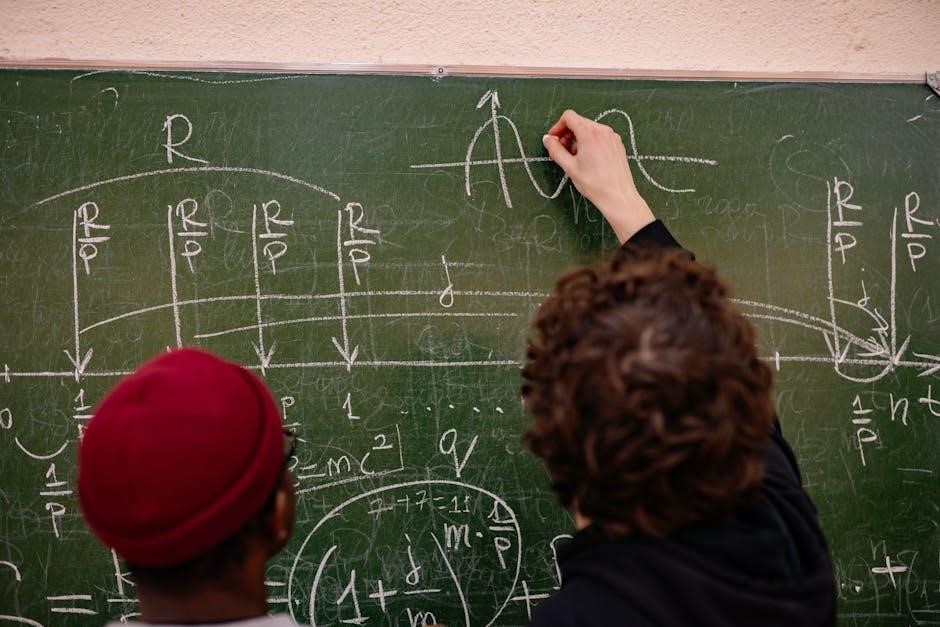Direct Instruction Mathematics is a teacher-directed, structured approach emphasizing explicit teaching and sequenced lessons to build foundational math skills effectively.
Research-backed and proven over decades, it benefits all learners, including at-risk students, through programs like DISTAR Arithmetic and Connecting Math Concepts.
Definition and Overview of Direct Instruction
Direct Instruction (DI) is a teacher-directed teaching method characterized by structured, sequenced lessons and explicit instruction. It emphasizes systematic presentation of academic content, breaking skills into smaller parts and teaching them incrementally. Teachers use clear demonstrations, step-by-step guidance, and controlled practice to ensure mastery. DI is grounded in decades of research, proving effective across diverse student populations, including at-risk and special education learners. Its focus on clarity, precision, and mastery makes it a foundational approach for teaching mathematics and other core subjects.
Importance of Direct Instruction in Mathematics Education
Direct Instruction is crucial for building strong foundational math skills, particularly for at-risk students. Its structured, teacher-led approach ensures clarity and precision, minimizing learning gaps. By breaking concepts into manageable parts and teaching incrementally, DI helps students achieve mastery. Research consistently shows significant academic gains, with effect sizes ranging from 0.79 to 2.44 across studies. This method is especially effective in early primary years, providing explicit guidance and practice essential for math proficiency. Its systematic design supports long-term success, making it a cornerstone of effective mathematics education.
Core Components of Direct Instruction Mathematics
Direct Instruction Mathematics emphasizes a structured, teacher-led approach with explicit teaching, sequenced curriculum design, and systematic lesson planning to ensure mastery of math concepts and skills.
Structured and Sequenced Curriculum Design
A cornerstone of Direct Instruction Mathematics is its structured and sequenced curriculum design. Lessons are carefully organized to ensure logical progression, building on previously mastered skills. This approach minimizes gaps in understanding by introducing concepts in a clear, incremental manner. Explicit teaching strategies and systematic lesson planning ensure that each step is purposeful and aligned with learning objectives. The curriculum is evidence-based, with programs like DISTAR Arithmetic and Connecting Math Concepts following a strand-based approach to math instruction. This design ensures that students gain a strong foundation in mathematics, with opportunities for practice and review to reinforce mastery.
Explicit Teaching Strategies
Explicit teaching strategies in Direct Instruction Mathematics involve clear, step-by-step explanations and demonstrations by teachers. These strategies ensure that students understand each concept before moving to the next. Modeling problems, breaking them into smaller parts, and guiding students through practice exercises are key components. The systematic and intentional nature of these strategies minimizes confusion and ensures mastery. Research highlights the effectiveness of explicit instruction, particularly for at-risk students, as it provides clarity and reduces ambiguity in learning mathematical concepts. This approach is foundational to the success of Direct Instruction programs in mathematics education.
Systematic Lesson Planning and Delivery
Systematic lesson planning and delivery are cornerstone components of Direct Instruction Mathematics. Lessons are carefully designed to ensure a logical progression of skills, with each concept building on the previous one. Teachers use clear objectives, sequenced activities, and timed deliveries to maintain focus and engagement. Instruction is divided into small, manageable increments, allowing students to master each step before advancing. This structured approach minimizes confusion and ensures that all students achieve proficiency. The systematic nature of these lessons is supported by decades of research, demonstrating their effectiveness in promoting long-term math success.
Key Direct Instruction Mathematics Programs
Direct Instruction Mathematics encompasses evidence-based programs like DISTAR Arithmetic, Corrective Mathematics, and Connecting Math Concepts, designed to build foundational math skills systematically and effectively.

DISTAR Arithmetic
DISTAR Arithmetic, developed by Engelmann and Carnine, is a cornerstone Direct Instruction program for teaching mathematics. Designed for elementary students, it focuses on building foundational arithmetic skills through explicit, step-by-step instruction. The program emphasizes clear demonstrations, guided practice, and systematic review to ensure mastery. Its structured approach ensures students progress logically, with each lesson building on previously learned concepts. Research has consistently shown DISTAR Arithmetic to be highly effective in improving math outcomes, particularly for students at risk of falling behind. Its evidence-based design makes it a reliable choice for educators seeking proven results.
Corrective Mathematics
Corrective Mathematics is a Direct Instruction program designed to address arithmetic deficits in students. It provides intensive, systematic instruction to fill skill gaps, ensuring mastery of essential math concepts. The program uses explicit teaching methods, including demonstrations, guided practice, and independent exercises. Corrective Mathematics is particularly effective for students who have struggled with traditional math instruction, offering a structured, step-by-step approach to build confidence and proficiency. Its focus on precision and fluency has made it a valuable resource for educators working with diverse learners, including those in special education settings.
Connecting Math Concepts (CMC)
Connecting Math Concepts (CMC) is a comprehensive Direct Instruction program designed to teach students to compute, solve problems, and think mathematically. The program includes levels A-F and a Bridge to F, offering a developmental approach that builds from basic to advanced skills. CMC emphasizes systematic instruction, explicit teaching strategies, and frequent practice to ensure mastery. It is particularly effective for students who benefit from structured, sequenced learning, helping them develop a strong foundation in mathematics and apply concepts to real-world problems with confidence and accuracy.

Effectiveness of Direct Instruction in Mathematics
Research consistently demonstrates that Direct Instruction significantly improves math outcomes, with effect sizes ranging from d = 0.79 to d = 2.44 across studies.
Research Findings and Effect Sizes
Research on Direct Instruction Mathematics reveals significant effectiveness, with effect sizes ranging from d = 0.79 to d = 2.44 across 39 studies. These studies, spanning 1972 to 2011, involved diverse student populations, including general and special education classrooms across all grade levels. Curriculum content included math, with 11 out of 12 reviewed programs showing positive outcomes. The findings, supported by Adams and Engelmann (1996) and Barbash (2012), highlight the robust impact of Direct Instruction on math achievement, making it a highly evidence-based approach for improving student learning outcomes in mathematics education.
Success Stories and Case Studies
Case studies highlight remarkable achievements through Direct Instruction Mathematics; For instance, Mastery Schools Australia reported significant literacy and numeracy gains using McGraw Hill DI programs, benefiting disengaged students. Similarly, schools adopting DI programs like Connecting Math Concepts and DISTAR Arithmetic have seen measurable improvements in math proficiency. These success stories emphasize how systematic, teacher-led instruction can empower students, particularly those at risk, to achieve academic success and build lasting confidence in mathematics, supported by over 60 years of evidence-based research.

Practical Applications of Direct Instruction in Math Classrooms
Direct Instruction Mathematics involves step-by-step modeling, guided practice, and systematic assessment to ensure mastery of math concepts, making it practical for classroom implementation and student success.
Step-by-Step Instruction and Modeling
Step-by-step instruction and modeling are cornerstone strategies in Direct Instruction Mathematics, enabling teachers to break down complex math concepts into manageable, logical sequences. By explicitly demonstrating each step of a problem, teachers ensure clarity and reduce confusion, allowing students to follow along and internalize the process. This method is particularly effective for struggling learners, as it provides a clear, structured pathway to understanding. Modeling also reinforces problem-solving techniques, helping students develop procedural fluency and confidence in tackling mathematical challenges independently. This approach aligns with research-backed practices, ensuring mastery and long-term retention of math skills.
Guided and Independent Practice
Guided and independent practice are essential components of Direct Instruction Mathematics, ensuring students apply and reinforce newly learned skills. Guided practice involves teacher-led exercises, where students work through problems collectively, receiving immediate feedback and support. This phase helps solidify understanding and address misconceptions. Independent practice allows students to apply skills on their own, fostering autonomy and confidence. Both phases are carefully structured to ensure mastery, with activities aligned to lesson objectives. Research shows this approach significantly improves math proficiency, as it provides ample opportunities for application and reinforcement of concepts.
Assessment and Mastery Tracking
Assessment and mastery tracking are integral to Direct Instruction Mathematics, ensuring students achieve complete understanding of each concept before progressing. Frequent, brief assessments are used to monitor progress and identify areas needing review. Mastery is defined by specific criteria, such as accurate and efficient problem-solving. Teachers adjust instruction based on assessment data, providing targeted support. This systematic approach ensures no student falls behind, fostering confidence and fluency in mathematics. By tracking mastery rigorously, Direct Instruction programs help educators deliver tailored instruction, maximizing student outcomes and long-term success;
The Debate: Direct Instruction vs. Inquiry-Based Learning
The debate between Direct Instruction and Inquiry-Based Learning centers on contrasting approaches to teaching mathematics, with Direct Instruction emphasizing explicit, structured lessons and Inquiry-Based Learning promoting student-led exploration and discovery, sparking discussions about effectiveness versus creativity in education.
Arguments in Favor of Direct Instruction
Proponents argue that Direct Instruction is highly effective for teaching mathematics, particularly for foundational skills and procedures. Its structured, teacher-directed approach ensures clarity and reduces ambiguity, benefiting all learners, especially at-risk students. Research consistently shows significant achievement gains, with effect sizes ranging from 0.79 to 2.44 across studies. Explicit teaching strategies, systematic lesson planning, and mastery tracking align with cognitive science principles, making it easier for students to build proficiency. Additionally, Direct Instruction addresses equity by providing all students access to the same high-quality instruction, bridging achievement gaps and fostering long-term success in mathematics.
Criticisms and Counterarguments
Critics argue that Direct Instruction can be overly rigid, limiting creativity and critical thinking. Some educators believe it prioritizes rote memorization over deeper understanding and problem-solving skills. Additionally, the teacher-centered approach may disengage students who prefer more interactive or inquiry-based learning experiences; Critics also suggest that Direct Instruction may not adequately prepare students for open-ended, real-world math problems. However, proponents counter that its structured nature ensures foundational mastery, which is essential for advanced problem-solving. They emphasize its proven effectiveness for diverse learners, particularly in building core mathematical proficiency.
Direct Instruction Mathematics offers an evidence-based, structured approach proven to enhance student outcomes, ensuring foundational mastery and long-term success in mathematical proficiency.
The Role of Direct Instruction in Modern Mathematics Education
Direct Instruction plays a pivotal role in modern math education by providing a structured, evidence-based approach that ensures mastery of foundational skills. Its teacher-directed, sequenced lessons align with the needs of diverse learners, particularly benefiting at-risk students. By emphasizing explicit teaching and systematic practice, DI complements contemporary educational goals, fostering confidence and proficiency in mathematics. It remains a cornerstone for educators seeking proven methods to address learning gaps and promote academic success in an ever-evolving educational landscape.
Future Directions and Recommendations

Future directions for Direct Instruction Mathematics include integrating technology to enhance explicit teaching methods and expanding professional development for educators. Schools should prioritize teacher training in DI strategies to ensure fidelity of implementation. Additionally, blending DI with complementary approaches, such as guided discovery, could address diverse learning needs. Policymakers should advocate for evidence-based programs like DISTAR and Connecting Math Concepts. Continuous research is essential to refine DI methods and adapt them to evolving educational demands, ensuring all students, including those at risk, achieve math proficiency and long-term success.